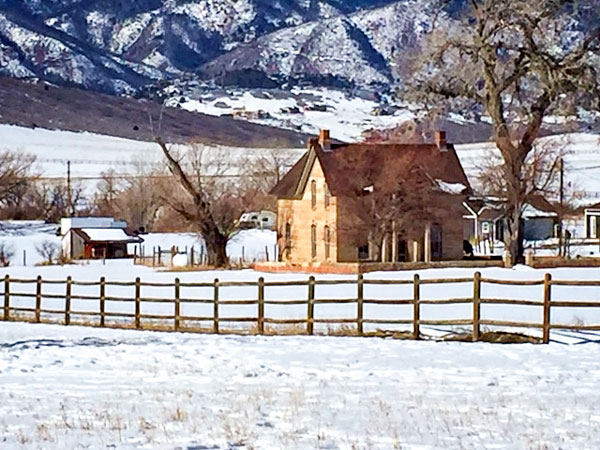The highs and lows of Benjamin and Mary Quick

Article and photo by Joe Gschwendtner

The Quick home of 1884 as seen in January 2020. Viewable from State Highway 105 and a builder’s masterwork for the day.
Ben Quick was born in Monroe County, Ohio in 1828. Orphaned at 10, he took interest in carpentry and by 16 had become a carpenter’s apprentice, moving to Missouri with his brother Cornelius.
Daring to dream big, when word of the gold strike at Sutter’s Mill rocketed eastward in 1849, they responded instantly, setting off on foot to Hangtown, California. The mines they worked in Shasta, California yielded gold, but not enough to breakeven.
Back in Missouri by 1852, Quick’s return proved beneficial when he courted and married Mary Jackson. Together they acquired interest in and worked a small farm for six years. Dreams of adventuring west came again, this time of Colorado. Selling the farm in 1858, they converted their money to horses, 50 head of cattle and two years of rations.
That balloon burst in Kansas. The Quicks encountered a 60-wagon team of Colorado territory returnees with epic tales of failure and woe. Cutting their losses, the Quicks returned to Missouri, selling off much of their gear to Mary’s brother. Yet the pioneer itch wouldn’t go away.
In 1864, two years later and behind a mule team, it was westward ho again. The third time was the charm. Winding up in the vicinity of Bear Canon Cemetery located near Wolfensberger Road and State Highway 105, the Quicks briefly occupied a small cabin. They then moved six miles south to a homestead on West Plum Creek in the Glen Grove area. From this point on, the Quicks’ prosperity and influence mushroomed. Their landholdings would eventually exceed 2,400 acres.
While proving up his land and building a cabin, he also helped his neighbors building a stockade, called Fort Washington. A godsend for all. Local Native American tribes were still generally restive after Colonel Chivington’s 1864 Sand Creek Massacre, in which 130 Native Americans were killed. In these matters, Quick was the local Paul Revere, known to ride fearlessly and alone to warn neighbors of pending attacks. The need for the fort greatly diminished, as armed veterans returned home at the Civil War’s end in 1865.
By 1884, Quick had fashioned the family a fine rhyolite home quarried from rock found on his own land. Also, among his handiwork was an irrigation dike known as Quick’s Ditch. A reservoir connected to it ensured his horses, cattle and crops had ample water throughout Colorado’s prolonged dry spells.
As more settlers arrived, so did a need for a qualified teacher for their children. To this end, he organized school district six and donated his own land to build the Glen Grove School. Subsequent generosity would yield another parcel for a cemetery. In 1902, Quick became a founder and later, director of the Douglas County Bank.
Hard work and achievement were hallmarks of the Quick family, but their lives were still pockmarked by pioneer pain. Of six children born to them, four died quite young, and a remaining daughter lost her life after giving birth to her first child. The Quicks are buried together in the Sinclaire Cemetery.